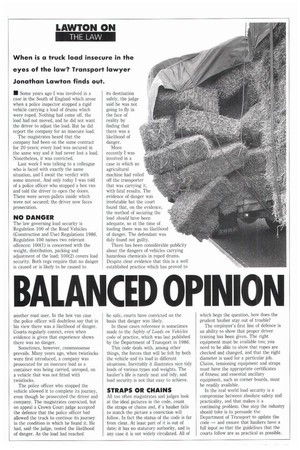BALANCED OPINION
Page 44

If you've noticed an error in this article please click here to report it so we can fix it.
When is a truck load insecure in the eyes of the law? Transport lawyer Jonathan Lawton finds out.
• Some years ago I was involved in a case in the South of England which arose when a police inspector stopped a rigid vehicle carrying a load of drums which were roped. Nothing had come off, the load had not moved, and he did not want the driver to adjust the load. But he did report the company for an insecure load.
The magistrates heard that the company had been on the same contract for 20 years; every load was secured in the same way and it had never lost a load. Nonetheless, it was convicted.
Last week I was talking to a colleague who is faced with exactly the same situation, and I await the verdict with some interest, And only today I was told of a police officer who stopped a box van and told the driver to open the doors. There were seven pallets inside which were not secured; the driver now faces prosecution.
NO DANGER
The law governing load security is Regulation 100 of the Road Vehicles (Construction and Use) Regulations 1986, Regulation 100 names two relevant offences: 100(1) is concerned with the weight, distribution, packing and adjustment of the load; 100(2) covers load security. Both regs require that no danger is caused or is likely to be caused to another road user. In the box van case the police officer will doubtless say that in his view there was a likelihood of danger. Courts regularly convict, even when evidence is given that experience shows there was no danger.
Sometimes, however, commonsense prevails. Many years ago, when twistlocks were first introduced, a company was prosecuted for an insecure load as a container was being carried, unroped, on a vehicle that was not fitted with twistlocks.
The police officer who stopped the vehicle allowed it to complete its journey, even though he prosecuted the driver and company. The magistrates convicted, but on appeal a Crown Court judge accepted the defence that the police officer had allowed the truck to continue its journey in the condition in which he found it. He had, said the judge, tested the likelihood of danger. As the load had reached its destination safely, the judge said he was not going to fly in the face of reality by finding that there was a likelihood of danger, More recently I was involved in a case in which an agricultural machine had rolled off the transporter that was carrying it, with fatal results. The evidence of danger was irrefutable but the court found that, on the evidence, the method of securing the load should have been adequate, so at the time of loading there was no likelihood of danger. The defendant was duly found not guilty.
There has been considerable publicity about the dangers of vehicles carrying hazardous chemicals in roped drums. Despite clear evidence that this is a well established practice which has proved to be safe, courts have convicted on the basis that danger was likely.
In these cases reference is sometimes made to the Safety of Loads on Vehicles code of practice, which was last published by the Department of Transport in 1986.
This code deals with, among other things, the forces that will be felt by both the vehicle and its load in different situations. Inevitably it illustrates nice tidy loads of various types and weights. The haulier's life is rarely neat and tidy, and load security is not that easy to achieve.
STRAPS OR CHAINS All too often magistrates and judges look at the ideal pictures in the code, count the straps or chains and, if a haulier fails to match the picture a conviction will follow. In fact the status of the code is far from clear. At least part of it is out of date; it has no statutory authority, and in any case it is not widely circulated. All of
which begs the question, how does the prudent haulier stay out of trouble?
The employer's first line of defence is an ability to show that proper driver training has been given. The right equipment must be available too; you need to be able to show that ropes are checked and changed, and that the right diameter is used for a particular job. Chains, tensioning equipment and straps must have the appropriate certificates of fitness; and essential ancillary equipment, such as corner boards, must be readily available.
In the real world load security is a compromise between absolute safety and practicality, and that makes it a continuing problem. One step the industry should take is to persuade the Department of Transport to update the code — and ensure that hauliers have a full input so that the guidelines that the courts follow are as practical as possible.




















































































